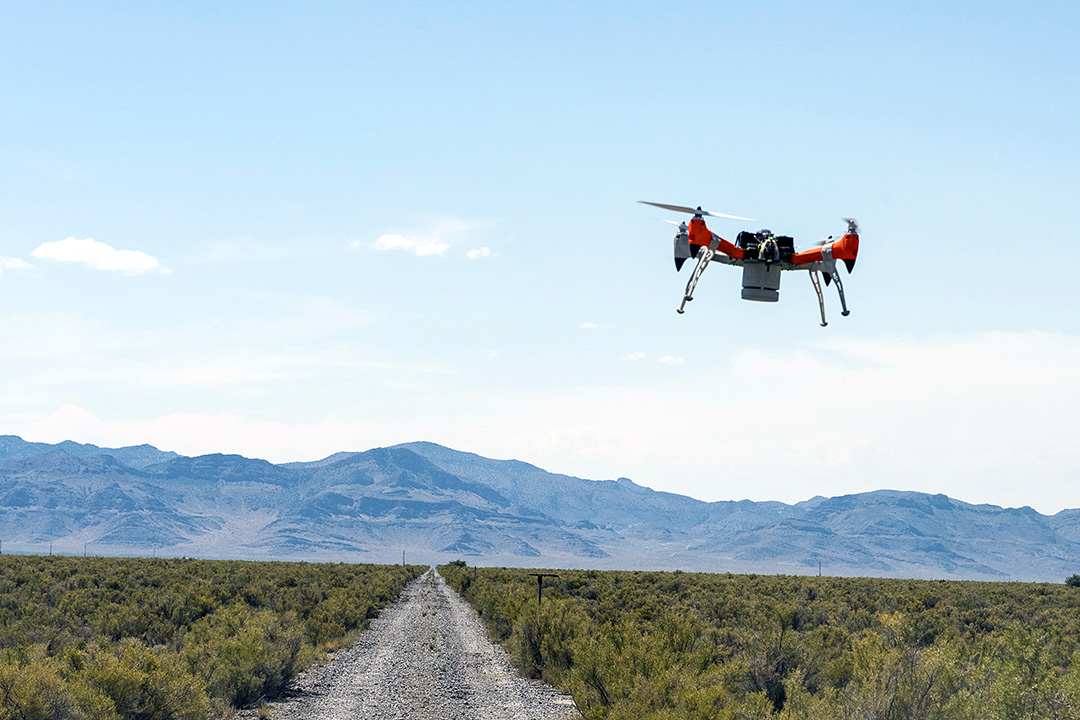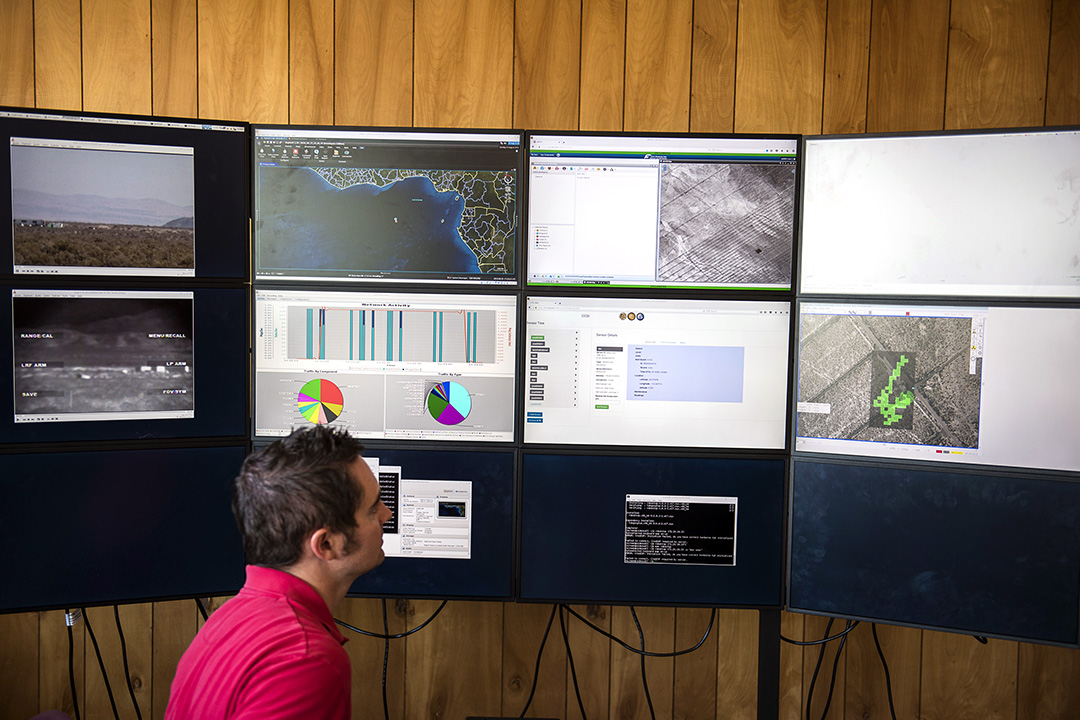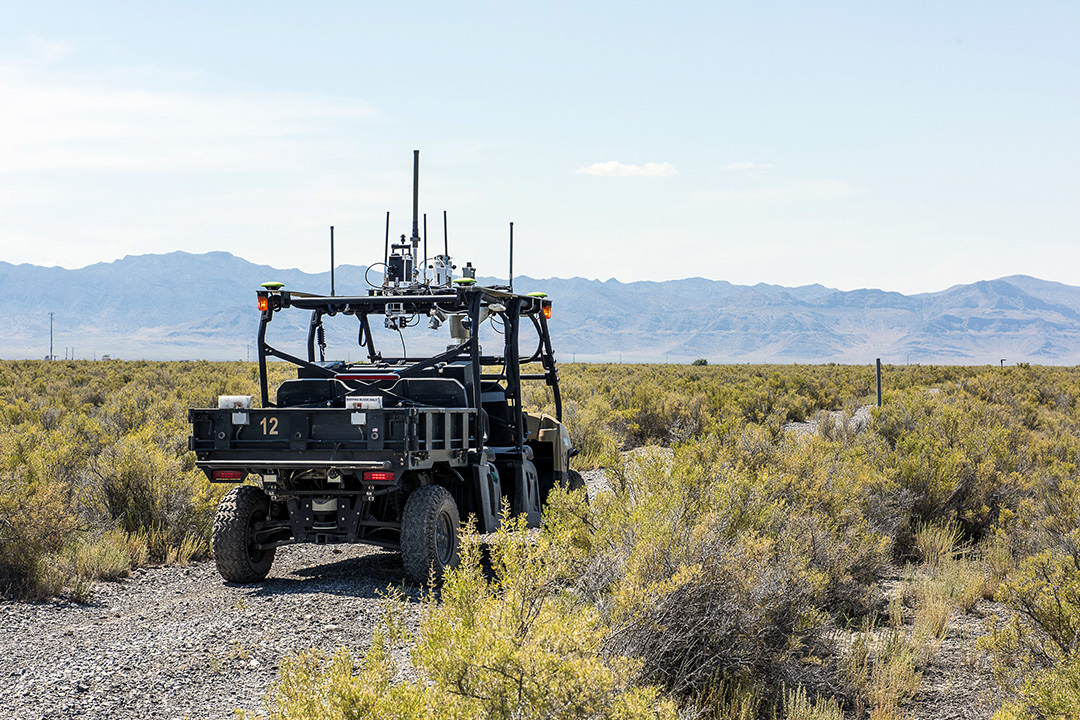// NEWS RELEASE
Bringing Chemical and Biological Detection into the Digital Age
ECBC Team Overcomes Heat, Wind, and Dust in Utah Desert to Prove a New Paradigm in Chemical Biological Defense.
CCDC Chemical Biological Center Public Affairs | November 2nd, 2016
Bringing Chemical and Biological Detection into the Digital Age
ECBC Team Overcomes Heat, Wind, and Dust in Utah Desert to Prove a New Paradigm in Chemical Biological Defense.
DEVCOM CBC Public AffairsNovember 2nd, 2016

ECBC's sensor loaded-drone, Deep Purple, lifts off to intercept a simulated chemical agent cloud as part of testing performed at the Dugway Proving Ground West Desert Test Center in August. (U.S. Army Photo / Albert C Vogel/Dugway Proving Ground Public Affairs)
It’s well past midnight and a team of ECBC scientists and engineers are hunched over computer screens inside a trailer waiting for an inversion layer to form over the desert outside so that a cloud of chemical agent simulant can be released.
Testing in the Desert Night
It is mid-August and the team is at Dugway Proving Ground’s West Desert Test Center in Utah. A quarter moon has set and the Milky Way dazzles overhead as teams from ECBC, private industry, and international observers from several NATO countries participate in an annual technology demonstration known as the SK Challenge.
A large monitor in the corner of the trailer shows the direction and speed of the wind as colored arrows. The arrows indicate that the conditions will be right in just moments, at which point another team from the ECBC BioTesting branch, located at Dugway and acting as referees for the demonstration in a nearby trailer, will signal a ground crew to release the simulant cloud. The members of the first ECBC team are visibly tense. Disembodied voices crackle over the radios.
“Six is online but I’ve got nothing that says ‘I’m alive’.”
“Five isn’t populating the monitor…wait, just got a ping.”
The communications for a technology orchestra are being tuned. Ground-based sensors will locate the cloud. Software in the trailer will communicate with those ground-based sensors and use their data to direct the mobile sensors to intercept the cloud. The mobile sensors, borne by a new generation of unmanned wheeled and aerial vehicles, will arrive at the cloud, identify the type of simulant in it, and communicate the data back to the sensor operators in the trailer.

Zero Hour
At 0330 hours the low rumble of a detonation rolls across the desert. The simulant cloud has been released – the starting gun. Two rotary wing drones, each bearing a cylinder under it packed with chemical sensors, rise vertically through the dust and in unison switch to a horizontal path disappearing into the desert night, red and green lights blinking as they disappear from view. They are quickly followed by an unmanned wheeled ground vehicle, looking much like a 4×4 all-terrain vehicle, but bristling with sensors on its roof, as it also disappears in a cloud of dust down a dirt road following the vectors being sent to it by the software in the trailer.
Within 20 minutes, the two aerial vehicles, one developed by ECBC and known as Deep Purple, the other a Honeywell T-Hawk fitted with a chemical sensor by the ECBC team, call home. Both systems accurately identified the simulant cloud.
Time for High Fives
“At that point there were a lot high fives all around,” said ECBC team leader and principal investigator Alan Samuels, Ph.D. “Standoff detection has been a challenge for the Army for a long time. Ground-based systems like LIDAR (light detection and ranging) and the CERBERUS camera (using visual and infrared light) have been around for a while to provide force protection surveillance, which signals the possibility of threats such as suspicious activity or a plume of particles or aerosols. They can track its location, but they don’t identify what’s in it.”
“On the other hand,” he continued, “unmanned flying vehicles mounted with sensors can identify what’s in the cloud but cannot loiter long enough to serve the surveillance function. By developing software that allow both types of sensors to talk to each other, we overcame their respective weaknesses and established a new paradigm for chemical and biological protection.”
The name for this new paradigm is the Layered Sensing Initiative, and its success in performing as a cohesive system at the SK Challenge proved in a very compelling way that the Initiative’s concept of integrated sensor architecture really is the future of chemical and biological defense.
Running the Entire System for the First Time
“It was the first large-scale demonstration of the system,” said Harold Wylie, a member of the Deep Purple development team. “Back at Aberdeen Proving Ground we tested a lot of the individual components, but we couldn’t test all of them together in concert because many of the components, such as the unmanned ground vehicle and the stationary surveillance sensors, weren’t ours.”
However, knowing that the SK Challenge would provide the opportunity to work with the entire system in one place, ECBC’s Battlefield Integration Branch spent months preparing for the Challenge by developing the software that allowed each component to communicate with the rest of the components in the system.
In addition, the ECBC team partnered with the Night Vision and Electronic Sensors Directorate at the Communications and Electronics Research, Development, and Engineering Center at Fort Belvoir, Va. The teams developed a “software bridge,” or translator, that conveys sensor data in the chemical and biological defense community’s communication protocol, the Common CBRN Sensor Interface, referred to as CCSI, into a more generic sensor data language called the Integrated Sensor Architecture, or ISA. ISA is the U.S. Army’s established and mandated electronic interoperability standard, ensuring that all the components of an integrated layered system can talk to each other and to the system’s operators.

Proving a Transformative Technology
This not only transforms the ability of commanders to gather situational awareness and plan a response, it changes the battlefield for the warfighter. Gone are the days when a unit’s protection was a single Soldier carrying an unconnected handheld device that often required going right up to the threat to get a reading or a sample. In the fully wired and automated chemical and biological sensing world, a drone or a ground robot enters the threat zone, detects the threat, and communicates the analytical results back through the Joint Warning and Reporting Network, called JWARN. The chain of command gets the detection and warning results in real time through JWARN, while Soldiers are alerted simultaneously through messages sent to Nett Warrior handheld devices.
“The difference between these networked devices and the ones we were developing as recently as five years ago is like comparing an old rotary dial phone to the latest smartphone,” said ECBC Director Joseph Corriveau. “It’s part of a CBRN sensor interoperability system in which all the parts can speak to each other in the same computer language, making it a profoundly powerful force multiplier.”
Only the Beginning
ECBC hopes to expand this capability to a web-based platform hosted in a cloud environment shared by the U.S. military chain of command and relevant healthcare agencies around the world. It will integrate information into a constantly updated dashboard providing users with near real-time data. However, Samuels’ ultimate goal is even bigger, “This is just the start. Over time, we plan to use the emerging capabilities of decision science and artificial intelligence to enter the realm of big data analytics and make this a self-learning, constantly evolving system.”
The success of the SK Challenge over the past four years has institutionalized it as an annual event. That makes it the venue by which continuously advancing and evolving versions of ECBC’s Layered Sensor Initiative will be tested, and its benefits shared with the national and international chemical biological defense community. The next SK Challenge will take place at the West Desert Testing Center August 8-17, 2017.
The U.S. Army Combat Capabilities Development Command (DEVCOM) leads in the discovery, development and delivery of technology-based capabilities to enable Soldiers to win our nation’s wars and come home safely. DEVCOM is a major subordinate command of the U.S. Army Futures Command. The DEVCOM Chemical Biological Center is the Army’s principal research and development center for chemical and biological defense technology, engineering and field operations. The DEVCOM Chemical Biological Center is headquartered at Aberdeen Proving Ground, Maryland.
